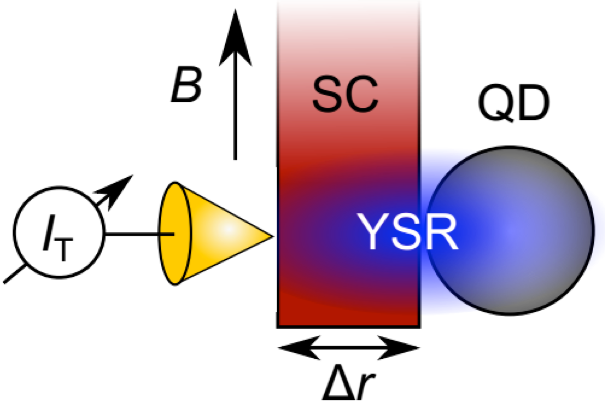2020. April 15.
BME physicists find an unexpectedly large extension of the Yu-Shiba-Rusinov (YSR) state in a superconducting nanostructure, a result which paves the way toward topologically protected qubits.. The work is published in Nature Communications, in collaboration with colleagues University of Basel.
Recent years have bought new quantum bit proposals, which are based on low-energy bound states in superconducting environment. These qubits would combine the properties of spin-based and superconductor-based qubits, and they are robust against noise-induced information loss. One such qubit is based on the so-called Yu-Shiba-Rusinov (YSR) state: a linear chain, engineered from such bound states, could host noise-protected quantum states. Due to the very small spatial extension of these states, making two of them interact with one another is difficult. Up to now, this was only possible by a very delicate technique, where individual ferromagnetic atoms are deposited next to each other.
In their new study, the MTA-BME Momentum Nanoelectronics Research Group realizated the YSR state in an alternative way: they attached an artificial atom to the superconductor's surface. This is the first time that the spatial extension of such a YSR state is measured. The measurement brought a surprising result: The size of the YSR state reaches 50-200 nanometers, which is significantly larger than the spatial extension observed in the case of real, ferromagnetic atoms. With state-of-the-art nanotechnology, artificial atoms can be routinely fabricated at such distances, which paves the way to realize YSR chains. The large extension of the YSR state has been theoretically explained in collaboration with another research group of BME’s Institute of Physics, the BME-MTA Exotic Quantum Phases Momentum Group.

Figure: Measurement of the spatial extension of the Yu-Shiba-Rusinov state. As an artificial atom (quantum dot, QD) is attached to a superconductor (SC), a Yu-Shiba-Rusinov state (blue) forms at the quantum dot and its surrounding in the superconductor. The YSR state is probed by measuring the current (IT) through an electrode on the left side of the superconductor. Despite the relatively large, 200 nanometer width of the superconductor, the YSR state was observed by the tunnel probe. In agreement with our calculations, the size of the YSR state increases further in a finite external magnetc field.
Large spatial extension of the zero-energy Yu-Shiba-Rusinov state in magnetic field
Nature Communications 11, 1834 (2020).
https://www.nature.com/articles/s41467-020-15322-9


